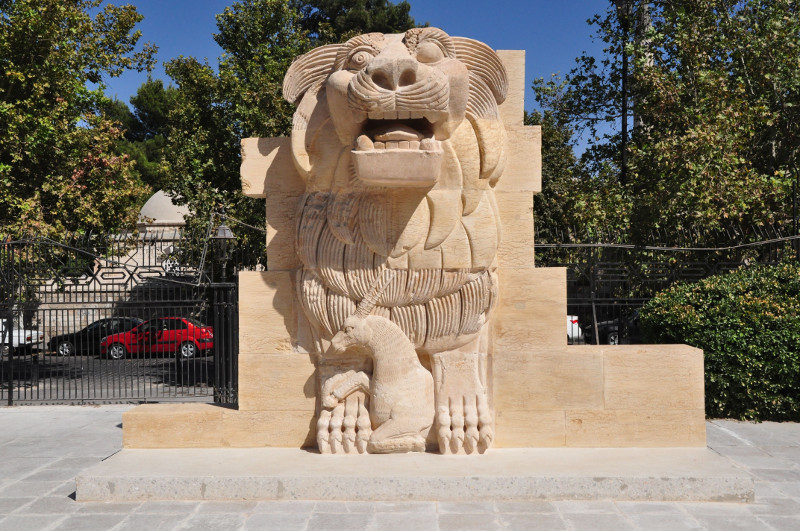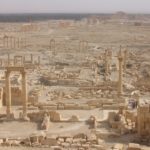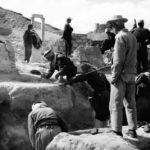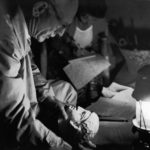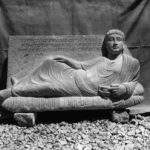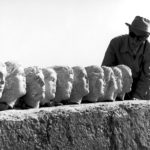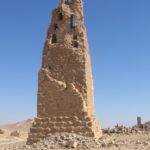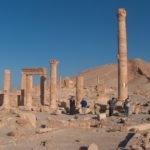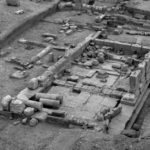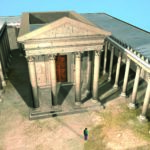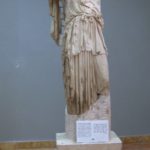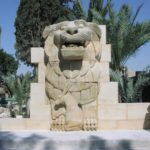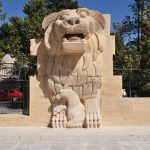Palmyra
Palmira, Tadmor
-
Type of site:
Settlement: ancient city and necropolis
Location:
Syria
Palmyra Oasis in the northern part of the Syrian Desert
Syrian Homs GovernorateDating:
– Mentions in written sources indicate that a town had existed in the oasis since at least the beginning of the 2nd millennium BC.
– Archaeologically studied remains date from the Roman to the early Islamic period:
– Roman period (1st century BC–4th century AD);
– Byzantine period (5th–7th century AD);
– Early Islamic period (7th–9th century AD).
– Since the 10th century AD, the settlement was limited to buildings in the area of the temenos of the former Temple of Bel.
– In the 13th century AD, an Arab castle was built on a hill towering above the city’s ruins.
Most interesting finds:
– Temple of Allat (1st–4th century AD) and two main sculptures: the statue of Athena and the low-relief sculpture of a lion-guard
– Principia – headquarters of the Roman army with the so-called Temple of the Standards
– Underground tombs (hypogea) of Zabda and Alaine with perfectly preserved funerary reliefs (2nd–3rd century AD)
– Two tower tombs of Kitot and Atenatan in the Valley of Tombs (first half of the 1st century AD)
– Multicolored mosaic from the banquet hall in one of the houses near the Great Colonnade (mid-3rd century AD)
– Complex of Christian basilicas (5th–6th century AD)
History of research:
Dates of PCMA mission’s work:
1959–2011
Type of research:
Excavations
Directors:
Kazimierz Michałowski (1959–1969)
Anna Sadurska (1970–1972)
Michał Gawlikowski (1973–2009)
Grzegorz Majcherek, PCMA UW (since 2010)
Co-operating institutions:
– Polish Centre of Mediterranean Archaeology, University of Warsaw
– Direction Générale des Antiquités et Museums of Syria
Description of the site and research:
Palmyra was a rich ancient caravan city that lay in an oasis in the middle of the Syrian Desert. Its heyday occurred during the Roman Empire (1st–3rd century AD) thanks to the favorable location on the ancient “Silk Route”, which allowed it to control the lucrative trade between the Mediterranean countries and Persia and the Far East.
Palmyra was then a densely populated city with a regular street grid, the impressive Great Colonnade, a monumental arch, a tetrapylon with 16 columns of Aswan granite, an agora surrounded by columns adorned with bronze statues of distinguished citizens, a theatre, baths, and temples: of Nabu, patron of writing and wisdom; of the Arab goddess Allat who was worshipped by nomadic tribes; of Baalshamin, “Lord of Heavens”, and finally the temple of Bel which was the largest and most magnificent building in the city and the symbol of its wealth.
The end of independence and prosperity of Palmyra was brought about in AD 272 by an unsuccessful attempt of the first Arab queen, Zenobia, to take imperial power, which ended in the conquest of the city by emperor Aurelian. Despite damages, the town survived and functioned until the early Middle Ages, although it grew poor and changed its character. It became more of a garrison after a Roman military complex, the so-called Diocletian’s Camp, was established there. Churches, which appeared together with Christianity at the end of antiquity, were with time and the onset of Islam replaced by mosques. The city fell into decline and once more became a small provincial settlement. Romantic ancient ruins waited for archaeologists.
The Polish mission from the Research Centre of Mediterranean Archaeology of the University of Warsaw, directed by Prof. Kazimierz Michałowski, first came to Palmyra in May 1959. Since then, excavations in different parts of town and on the necropolis have resulted in spectacular discoveries, which were important for the study of the history and material culture of its inhabitants.
These discoveries include the building of the principia (command headquarters of the Roman camp with the so-called Temple of the Standards), the temple of goddess Allat from the 1st–4th century AD, a complex of Christian basilicas from the 5th–6th century AD, underground tombs (hypogea) of Zabda and Alaine with perfectly preserved funerary reliefs, two tower tombs of Kitot and Atenatan in the Valley of Tombs, a multicolored mosaic from the banquet hall in one of the houses near the Great Colonnade (mid-3rd century AD). This last discovery is very valuable since mosaics are extremely rare in Palmyra. It depicts the Greek hero Bellerophon slaying the Chimaera. Moreover, Polish researchers also determined that the Arab castle on the hill above the city was built in the 13th century and not in the 16th century, as was thought earlier.
Until 2015, numerous finds from the Polish excavations – including a large low-relief of a lion guarding the sanctuary of Allat; a unique marble statue of Athena; a gold hoard consisting of coins and jewelry; sculptures and funerary reliefs – constituted an important part of the collection of the archaeological museum in Palmyra. Lamentably, many of them do not exist anymore.
The Palmyrenian Tariff
Just before work in Palmyra was interrupted by the armed conflict (2010¬–2011 seasons), Polish archaeologists found the place where the famous Palmyrenian Tariff stood in ancient times. It was a large stone slab on which an inscription in Greek and Aramaic, with the text of a customs act describing local trade and tolls on imported products, was carved in AD 137.
Cut into four pieces, the stele became part of the collection of the Hermitage Museum in Saint Petersburg in 1904, given to the tsar of Russia by the Turkish sultan. Unfortunately, no documentation was made during its dismantling and transport. The results of work conducted by the Polish team filled the gap in the knowledge about this monument.
Research results:
Season by season – “PCMA Newsletter”:
Associated events:
April 2022: Promotion of Prof. Gawlikowski’s book “Tadmor – Palmyra”
October 2021: Open Access: Prof. Gawlikowski’s book on the temple of Allat in Palmyra
December 2019: Prof. Michał Gawlikowski with Prof. Jan Zachwatowicz Award
October 2017: The restored low-relief of the Lion of Palmyra in the National Museum in Damascus
July 2017: The Lion of Palmyra at UNESCO session in Kraków
May 2017: The Lion of Palmyra is PCMA new logo
April 2017: Exhibition “Against the Sands of Time. Documentation and Reconstruction of the World Heritage – the Polish Experience”
May 2016 Polish specialists return to Palmyra
March–April 2016: Exhibition on PCMA research in Syria and Iraq
April 2016: Conference: “Poles in the Near East”, special session: “Endangered Heritage. Archaeological Research and Conservation in Syria and Iraq”
April 2016: Conference “Life in Palmyra, life for Palmyra”
April 2016: Press conference on Palmyra
April 2016: PCMA experts visited Palmyra
August 2015: Professor Michał Gawlikowski on Palmyra
August 2015: Khaled el Assad (1934-2015)
December 2010: Conference “Palmyra – queen of the desert. 50 years of polish excavations in Palmyra 1959-2009”
June 2010: Oasis of the Imagination – exhibition commemorating fifty years of Polish archaeological research at Palmyra
Gawlikowski, M. (2021). Tadmor–Palmyra. A Caravan City between East and West, (=Bibliotheca Artibus et Historiae), Krakow: IRSA.
Gawlikowski, M. (2019). Roman Housing in Palmyra, in: G. Bąkowska‑Czerner, R. Czerner (eds), Greco‑Roman Cities at the Crossroads of Cultures, Oxford: Archaeopress, 103–108.
Majcherek, G. (2019). Filling the gap: Mediterranean amphorae in Late antique Palmyra, Syria, 96, 395–418 DOI : https://doi.org/10.4000/syria.10620.
Gawlikowski, M. (2017). Gods and Places: Local and Oecumenical Cults in Syria in the Imperial Period, in: R. Raja (ed.), Contextualising the Sacred in the Hellenistic and Roman Near East. Religious Identities in Local, Regional and Imperial Settings, Brepols, Turnhout, 11–29.
Gawlikowski, M. (2017). Le sanctuaire d’Allat à Palmyre (=PAM Monograph Series 8), Warsaw: PCMA, WUP https://doi.org/10.31338/uw.9788323535010 .
Gawlikowski, M. (2016). The portraits of the Palmyrene royalty. In A. Kropp and R. Raja (eds), The world of Palmyra (pp. 126–134). Copenhagen: Det Kongelige Danske Videnskabernes Selskab.
Gawlikowski, M. (2016). Trade Across Frontiers: Foreign Relations of a Caravan City, in: J.Ch. Meyer, E.H. Selund, N. Affinset (eds), Palmyrena. City, Hinterland and Caravan Trade between Orient and Occident, Oxford: Archaeopress, 19–28.
Wielgosz-Rondolino, D. (2016). Orient et Occident unis par enchantement dans la pierre sculptée. La sculpture figurative de Palmyre. In M. Maqdissi and É. Ishaq (eds), La Syrie et le désastre archéologique du Proche-Orient “Palmyre cité martyre” (pp. 65–82). Beyrouth: Beiteddine Art Festival.
Wielgosz-Rondolino, D. (2016). Palmyrene portraits from the temple of Allat. New evidence on artists and workshops. In A. Kropp and R. Raja (eds), The world of Palmyra (pp. 166–179). Copenhagen: Det Kongelige Danske Videnskabernes Selskab.
Gawlikowska, K. (2015). A new look on some old glass finds from Palmyra. Polish Archaeology in the Mediterranean, 24/1, 779–790.
Krzyżanowska, A. and Gawlikowski, M. (2014). Monnaies des fouilles polonaises á Palmyre (=Studia Palmyreńskie 13). Warsaw: University of Warsaw Press.
Gawlikowski, M. (2014). Palmyra: reexcavating the site of the Tariff (fieldwork in 2010 and 2011). Polish Archaeology in the Mediterranean, 23/1, 415–430.
Gawlikowski, M. (2013). In the footsteps of Prince Abamelek in Palmyra. In M. Gawlikowski and G. Majcherek (eds), Fifty years of Polish excavations in Palmyra 1959–2009: International conference, Warsaw, 6–8 December 2010 (=Studia Palmyreńskie 12) (pp. 87–96). Warsaw: University of Warsaw Press.
Gawlikowski, M. and Majcherek, G. (eds). (2013). Fifty years of Polish excavations in Palmyra 1959–2009: International conference, Warsaw, 6–8 December 2010 (=Studia Palmyreńskie 12). Warsaw: University of Warsaw Press.
Jastrzębowska, E. (2013). La christianisation de Palmyre: l’exemple du temple de Bel. In M. Gawlikowski and G. Majcherek (eds), Fifty years of Polish excavations in Palmyra 1959–2009: International conference, Warsaw, 6–8 December 2010 (=Studia Palmyreńskie 12) (pp. 177–192). Warsaw: University of Warsaw Press.
Juchniewicz, K. (2013). Late Roman fortifications in Palmyra. Studia Palmyreńskie, 12, 193–202.
Juchniewicz, K. and Żuchowska, M. (2013). Remarks on water supply in Palmyra. Results of a survey in 2010. Polish Archaeology in the Mediterranean, 22, 341–350.
Kubiak, A. (2013). Des “dieux bons” à Palmyre. In M. Gawlikowski and G. Majcherek (eds), Fifty years of Polish excavations in Palmyra 1959–2009: International conference, Warsaw, 6–8 December 2010 (=Studia Palmyreńskie 12) (pp. 227–234). Warsaw: University of Warsaw Press.
Majcherek, G. (2013). Excavating the basilicas. In M. Gawlikowski and G. Majcherek (eds), Fifty years of Polish excavations in Palmyra 1959–2009: International conference, Warsaw, 6–8 December 2010 (=Studia Palmyreńskie 12) (pp. 251–268). Warsaw: University of Warsaw Press.
Wielgosz, D. (2013). Coepimus et lapide pingere: marble decoration from the so-called baths of Diocletian in Palmyra. In M. Gawlikowski and G. Majcherek (eds), Fifty years of Polish excavations in Palmyra 1959–2009: International conference, Warsaw, 6–8 December 2010 (=Studia Palmyreńskie 12) (pp. 319–332). Warsaw: University of Warsaw Press.
Żuchowska, M. (2013). Palmyra and the far eastern trade. In M. Gawlikowski and G. Majcherek (eds), Fifty years of Polish excavations in Palmyra 1959–2009: International conference, Warsaw, 6–8 December 2010 (=Studia Palmyreńskie 12) (pp. 381–388). Warsaw: University of Warsaw Press.
Gawlikowski, M. (2012). Le Tarif de Palmyre et le temple de Rab‘asirê. Comptes rendus de l’Académie des inscriptions et belles-lettres, 2012(2), 765–780.
Majcherek, G. (2012). Polish Archaeological Mission to Palmyra. Seasons 2008 and 2009. Polish Archaeology in the Mediterranean, 21, 459–479.
Gawlikowski, M. (2010). Odainat of Palmyra between Rome and Persia. In E. Dąbrowa (ed.), Hortus historiae: Studies in honour of Professor Józef Wolski on the 100th anniversary of his birthday (pp. 467–479). Kraków: Historia Iagellonica.
Gawlikowski, M. (2010). Palmyra. Preliminary report on the forty-fifth season of excavations. Polish Archaeology in the Mediterranean, 19, 517–526.
Gawlikowski, M. (2010). The Roman army in Palmyra under Tiberius. Studia Palmyreńskie, 11, 49–54.
Gawlikowski, M. and al-As’ad, K. (2010). The Imperial cult in Palmyra under the Antonines. Studia Palmyreńskie, 11, 43–48.
Gawlikowski, M. and Żuchowska, M. (2010). La mosaïque de Bellérophon. Studia Palmyreńskie, 11, 9–42.
Juchniewicz, K., al-As’ad, K., and al Hariri, K. (2010). The defense wall in Palmyra after recent Syrian excavations. Studia Palmyreńskie, 11, 55–74.
Wielgosz, D. (2010). La sculpture en marbre à Palmyre. Studia Palmyreńskie, 11, 75–106.
Żuchowska, M. (2010). The Western Gate at Palmyra. Studia Palmyreńskie, 11, 107–114.
Gawlikowski, M. (2009). A lonely hunter from Palmyra. In J.M. Burdukiewicz (ed.), Understanding the past: Papers offered to Stefan K. Kozłowski (pp. 123–129). Warsaw: Center for Research on the Antiquity of Southeastern Europe. University of Warsaw.
Gawlikowski, M. (2008). Palmyra. Excavations in the Allat sanctuary, 2005–2006. Polish Archaeology in the Mediterranean, 18, 531–541.
Gawlikowski, M. (2008). Palmyra in the Early Islamic times. In K. Bartl and A.A.-R. Moaz (eds), Residences, castles, settlements: Transformation processes from late antiquity to Early Islam in Bilad al-Sham. Proceedings of the International Conference held at Damascus, 5–9 November 2006 (=Orient-Archäologie 24) (pp. 89–96). Rahden/Westf.: M. Leidorf.
Gawlikowski, M. (2008). The statues of the sanctuary of Allat in Palmyra. In Y.Z. Eliav, E.A. Friedland, and S. Herbert (eds), The sculptural environment of the Roman Near East: reflections on culture, ideology, and power (=Interdisciplinary Studies in Ancient Culture and Religion 9) (pp. 397–411). Leuven–Dudley, MA: Peeters.
Gawlikowski, M. (2007). Beyond the colonnades. The housing architecture in Palmyra. In K. Galor and T. Waliszewski (eds), From Antioch to Alexandria: Recent studies in domestic architecture (pp. 79–93). Warsaw: Institute of Archaeology, University of Warsaw.
Żuchowska, M. (2007). Palmyra. Excavations 2002–2005 (insula E by the Great Colonnade). Polish Archaeology in the Mediterranean, 17, 439–450.
Gawlikowski, M. (2005). Palmyra 2004. Polish Archaeology in the Mediterranean, 16, 461–465.
Kaim, B. (2005). Palmyrenes and Parthian costume. In P. Bieliński and F.M. Stepniowski (eds), Aux pays d’Allat: mélanges offerts à Michał Gawlikowski (pp. 113–122). Warszawa: Instytut Archeologii, Uniwersytet Warszawski.
Krogulska, M. (2005). A lamp from the cella of the temple of Allat in Palmyra. In P. Bieliński and F.M. Stepniowski (eds), Aux pays d’Allat: mélanges offerts à Michał Gawlikowski (pp. 123–129). Warszawa: Instytut Archeologii, Uniwersytet Warszawski.
Majcherek, G. (2005). More churches from Palmyra – an inkling of the late antique city. In P. Bieliński and F.M. Stepniowski (eds), Aux pays d’Allat: mélanges offerts à Michał Gawlikowski (pp. 141–150). Warszawa: Instytut Archeologii, Uniwersytet Warszawski.
Markowski, B. (2005). The lion of Allat in Palmyra. New museum display project. Polish Archaeology in the Mediterranean, 16, 470–474.
Trochimowicz, A. and Markowski, B. (2005). Restoration work in the Palmyra Museum in 2004. Polish Archaeology in the Mediterranean, 16, 466–469.
Wielgosz, D. (2005). La présence de marbres précieux a Palmyre. In P. Bieliński and F.M. Stepniowski (eds), Aux pays d’Allat: mélanges offerts à Michał Gawlikowski (pp. 303–323). Warszawa: Instytut Archeologii, Uniwersytet Warszawski.
Żuchowska, M. (2005). Palmyre – cité caravaniere? In P. Bieliński and F.M. Stepniowski (eds), Aux pays d’Allat: mélanges offerts à Michał Gawlikowski (pp. 325–347). Warszawa: Instytut Archeologii, Uniwersytet Warszawski.
Gawlikowski, M. (2004). Palmyra. Season 2003, preliminary report. Polish Archaeology in the Mediterranean, 15, 313–324.
Wielgosz, D. (2004). Osservazioni sul sarcofago palmireno. In M. Fano Santi (ed.), Studi di archeologia in onore di Gustavo Traversari (pp. 929–962). Roma: Bretschneider.
Gawlikowski, M. (2003). Palmyra: from a tribal federation to a city. In K.S. Freyberger, A. Henning, and H. von Hesberg (eds), Kulturkonflikte im Vorderen Orient an der Wende vom Hellenismus zur römischen Kaiserzeit (=Orient-Archäologie 11) (pp. 7–10). Rahden/Westf.: M. Leidorf.
Gawlikowski, M. (2003). Palmyra. Season 2002. Polish Archaeology in the Mediterranean, 14, 279–290.
Gawlikowski, M. (2003). Un nouveau temple d’Allat dans une inscription revisitée. Semitica, 51, 57–64.
Żuchowska, M. (2003). Test trench in the street of the Great Colonnade. Polish Archaeology in the Mediterranean, 14, 291–294.
Gawlikowski, M. (2002). Palmyra. Season 2001. Polish Archaeology in the Mediterranean, 13, 257–269.
Wielgosz, D., Lazzarini, L., Turi, B., and Antonelli, F. (2002). The origin of the marble sculptures from Palmyra. In L. Lazzarini (ed.), Interdisciplinary studies on ancient stone: Asmosia VI . Proceedings of the sixth international conference of the Association for the Study of Marble and Other Stones in Antiquity, Venice, June 15–18, 2000 (pp. 389–402). Padua: Bottega d’Erasmo.
Wielgosz, D. (2001). Sarcofagi attici a Palmira. Rivista di Archeologia, 25, 167–176.
Gawlikowski, M. (2000). Palmyra. Season 1999. Polish Archaeology in the Mediterranean, 11, 249–260.
Wielgosz, D. (2000). Le sculture in marmo proconnesio a Palmira. Rivista di Archeologia, 24, 96–105.
Gawlikowski, M. (1999). Palmyra: Excavations, 1998. Polish Archaeology in the Mediterranean, 10, 189–196.
Gawlikowski, M. (1998). Palmyra: Excavations 1997. Polish Archaeology in the Mediterranean, 9, 197–211.
al-As’ad, K. and Gawlikowski, M. (1997). The inscriptions in the museum of Palmyra: A catalogue. Palmyre; Warsaw.
Barański, M. (1997). The western aqueduct in Palmyra. Studia Palmyreńskie, 10, 7–17.
Daszkiewicz, M. and Raabe, J. (1997). Glass from Palmyra in laboratory studies. Polish Archaeology in the Mediterranean, 8, 199–202.
Gawlikowski, M. (1997). L’habitat à Palmyre de l’Antiquité au Moyen-Age. In C. Castel, M. al-Maqdissi, and F. Villeneuve (eds), Les maisons dans la Syrie antique du IIIe millénaire aux débuts de l’Islam: pratiques et représentations de l’espace domestique. Actes du colloque international, Damas, 27–30 juin 1992 (=Bibliothèque archéologique et historique 150) (pp. 161–166). Beirut: Institut français du Proche-Orient.
Gawlikowski, M. (1997). Palmyra, excavations 1996. Polish Archaeology in the Mediterranean, 8, 191–197.
Gawlikowski, M. and al-As’ad, K. (1997). Inscriptions de Palmyre nouvelles et revisitées. Studia Palmyreńskie, 10, 23–38.
Kowalski, S.P. (1997). Late Roman Palmyra in literature and epigraphy. Studia Palmyreńskie, 10, 39–62.
Pietrzykowski, M. (1997). Adyta świątyń palmyreńskich: studium funkcji i formy (Adyta of the Palmyrene temples: a study of function and form). Warsaw: Archet.
Scholl, T. and Taha, A. (1997). Sounding in the courtyard of the Saray in Palmyra (1986). Studia Palmyreńskie, 10, 63–68.
Wielgosz, D. (1997). Funeralia Palmyrena. Studia Palmyreńskie, 10, 69–77.
Barański, M. (1996). Development of the building techniques in Palmyra. Annales Archéologiques Arabes Syriennes, 42, 379–384.
Byliński, J. (1996). Palmyra. Arab Castle 1995. Polish Archaeology in the Mediterranean, 7, 147–159.
Gawlikowski, M. (1996). Palmyra. Excavations 1995. Polish Archaeology in the Mediterranean, 7, 139–146.
Gawlikowski, M. (1996). The Athena of Palmyra. Archeologia, 47, 21–32.
Kowalski, S.P. (1996). Doubtful Christian reutilization of the Baalshamin temple in Palmyra. Damaszener Mitteilungen, 9, 217–226.
Barański, M. (1995). Building techniques in Palmyra. In Studies in the history and archaeology of Jordan V. Art and technology throughout the ages (pp. 231–233). Amman: Department of Antiquities of Jordan.
Byliński, J. (1994). Survey of the Arab Castle in Palmyra, 1993. Polish Archaeology in the Mediterranean, 5, 144–153.
Daszkiewicz, M. (1994). An archaeometric study of ceramic and clay samples from Palmyra. Studia Palmyreńskie, 9, 1–4.
Gawlikowska, K. and al-As’ad, K. (1994). The collection of glass vessels in the Museum of Palmyra. Studia Palmyreńskie, 9, 5–36.
Gawlikowski, M. (1994). Palmyra. Polish Archaeology in the Mediterranean, 5, 133–143.
Gawlikowski, M. (1994). Palmyra as a trading centre. Iraq, 56, 27–33.
Kowalski, S.P. (1994). The Praetorium of the Camp of Diocletian in Palmyra. Studia Palmyreńskie, 9, 39–70.
Witecka, A. (1994). Catalogue of jewellery found in the Tower-tomb of Atenatan in Palmyra. Studia Palmyreńskie, 9, 71–91.
Gawlikowski, M. (1993). Palmyra 1992. Polish Archaeology in the Mediterranean, 4, 111–118.
Gawlikowski, M. (1992). Palmyra 1991. Polish Archaeology in the Mediterranean, 3, 68–76.
Barański, M. (1991). Opus Palmyrenum. Damaszener Mitteilungen, 5, 59–63.
Byliński, J. (1991). The Arab Castle in Palmyra. Polish Archaeology in the Mediterranean, 2, 91–93.
Gawlikowski, M. (1991). Palmyra. Polish Archaeology in the Mediterranean, 2, 85–90.
Gawlikowski, M. (1990). Le premier temple d’Allat. In P. Matthiae, M.N. van Loon, and H. Weiss (eds), Resurrecting the past: A joint tribute to Adnan Bounni (=Uitgaven van het Nederlands Historisch-Archaeologisch Instituut te İstanbul 67) (pp. 101–108). Istanbul: Nederlands Historisch-Archaeologisch Instituut.
Gawlikowski, M. (1990). Les dieux de Palmyre. In W. Haase (ed.), Aufstieg und Niedergang der Römischen welt II.18.4. Principat. Religion (Heidentum: Die religiösen Verhältnisse in den Provinzen (Forts.)) (pp. 2605–2658). Berlin: de Gruyter.
Gawlikowski, M. (1990). Palmyra. Polish Archaeology in the Mediterranean, 1, 37–44.
Gawlikowski, M. (1988). Le commerce de Palmyre sur terre et sur eau. In L’Arabie et ses mers bordières I. Itinéraires et voisinages. Séminaire de recherche 1985–1986 (=Travaux de la Maison de l’Orient 16/1)(pp. 163–172). Lyon: Maison de l’Orient et de la Méditerranée.
al-As’ad, K. and Gawlikowski, M. (1986–1987). New honorific inscriptions in the Great Colonnade of Palmyra. Annales Archéologiques Arabes Syriennes, 36–37, 164–171.
Gawlikowski, M. (1986). Les comptes d’un homme d’affaires dans une tour funéraire à Palmyre. Semitica, 36, 87–99.
Gawlikowski, M. (1985). Świątynia Allat w Palmyrze. Wstępny raport z wykopalisk 1974–1976 (The temple of Allat in Palmyra. Preliminary report from the 1974–1976 excavations). Studia Palmyreńskie, 8, 5–25.
Krogulska, M. (1985). A ceramic workshop in the western quarter of Palmyra. Studia Palmyreńskie, 8, 43–67.
Makowski, K. (1985). La sculpture funéraire palmyrénienne et sa fonction dans l’architecture sépulcrale. Studia Palmyreńskie, 8, 69–117.
Makowski, K. (1985). Recherches sur le banquet miniaturisé dans l’art funéraire de Palmyre. Studia Palmyreńskie, 8, 119–130.
Meyza, H. (1985). Remarks on the western aqueduct of Palmyra. Studia Palmyreńskie, 8, 27–33.
Sadurska, A. and Makowski, K. (1985). Les sculptures palmyréniennes provenant des fouiles polonaises en 1972 dans le “Tombeau Turriforme”: (l’Enceinte de Dioclétien). Studia Palmyreńskie, 8, 35–41.
Starcky, J. and Gawlikowski, M. (1985). Palmyre: édition revue et augmentée des nouvelles découvertes. Paris: Librairie d’Amérique et d’Orient.
Gawlikowski, M. (1984). Les principia de Dioclétien : “Temple des Enseignes” (=Palmyre 8). Varsovie: Éditions Scientifiques de Pologne.
Krogulska, M. (1984). Le forum. In M. Gawlikowski, Les principia de Dioclétien : “Temple des Enseignes” (=Palmyre 8) (pp. 70–91). Varsovie: Éditions Scientifiques de Pologne.
Gawlikowski, M. (1983). Le sanctuaire d’Allat à Palmyre : aperçu préliminaire. Annales Archéologiques Arabes Syriennes, 33, 179–198.
Gawlikowski, M. (1983). Palmyre et l’Euphrate. Syria, 60(1), 53–68.
Gawlikowski, M. (1983). Réflexions sur la chronologie du sanctuaire d’Allat à Palmyre. Damaszener Mitteilungen, 1, 59–68.
Gawlikowski, M. (1983). Une tête d’Athéna. Études et Travaux, 13, 89–97.
Gąssowska, B. (1982). Maternus Cynegius, praefectus praetorio Orientis and the destruction of the Allat Temple in Palmyra. Archeologia, 33, 107–123.
Gawlikowski, M. and Pietrzykowski, M. (1980). Sculptures du temple de Baalshamin à Palmyre. Syria, 57(2), 421–452.
Gawlikowski, M. (1977). Le temple d’Allat à Palmyre. Revue Archéologique, 2, 253–274.
Sadurska, A. (1977). Le tombeau de famille de ʻAlainê (=Palmyre 7). Warsaw: PWN-Éditions scientifiques de Pologne.
Gawlikowski, M. (1976). Allat et Baalshamîn. In Mélanges d’histoire ancienne et d’archéologie offerts à Paul Collart (=Cahiers d’archéologie romande de la Bibliothèque historique vaudoise 5) (pp. 197–203). Lausanne: Bibliothèque historique vaudoise.
Gawlikowski, M. (1976). Le Camp de Dioclétien: bilan préliminaire. In Palmyre: bilan et perspectives (pp. 153–163). Strasbourg: A.E.C.R.
Brykczyński, P. (1975). Astrologia w Palmyrze (Astrology in Palmyra). Studia Palmyreńskie, 6–7, 47–109.
Gawlikowski, M. (1975). Recueil d’inscriptions palmyréniennes provenant de fouilles syriennes et polonaises récentes à Palmyre. Mémoires présentés par divers savants étrangers à l’Académie, 16(1), 263–377.
Gawlikowski, M. (1975). Remarks on the ramparts of Palmyra. Studia Palmyreńskie, 6–7, 45–46.
Gawlikowski, M. (1975). Trois inscriptions funéraires du Camp de Dioclétien. Studia Palmyreńskie, 6–7, 127–133.
Makowski, K. (1975). Bogowie i meharyści (Gods and meharists). Studia Palmyreńskie, 6–7, 137–149.
Sadurska, A. (1975). Palmyre 1972. Tombeaux dans l’enceinte du Camp de Dioclétien. Études et Travaux, 8, 367–376.
Sadurska, A. (1975). Une nouvelle tessère de Palmyre. Studia Palmyreńskie, 6–7, 121–126.
Sadurska, A. (1975). Wykopaliska polskie w Palmyrze 1970: „Świątynia Sztandarów” (Polish excavations in Palmyra in 1970: “Temple of the Standards”). Studia Palmyreńskie, 6–7, 111–119.
Gawlikowski, M. (1974). Le tadmoréen. Syria, 51(1), 91–103.
Krzechowicz, G. (1974). Uwagi nad genezą świątyń palmyreńskich (Remarks on the origins of Palmyrene temples). Studia Palmyreńskie, 5, 45–82.
Łukasiak, E. (1974). Ikonografia Yarhibôla (The iconography of Yarhibôl). Studia Palmyreńskie, 5, 7–44.
Myśliwiec, K. (1974). Sculptures trouvées à Palmyre par la mission archéologique polonaise en 1968 et 1969. Studia Palmyreńskie, 5, 83–96.
Wais, J. (1974). Malakbel and Melqart. Studia Palmyreńskie, 5, 97–101.
Gawlikowski, M. (1973). Le temple palmyrénien: étude d’épigraphie et de topographie historique (=Palmyre 6). Varsovie: Éditions Scientifique de Pologne.
Gawlikowski, M. (1973). Liturges et custodes. Sur quelques inscriptions palmyréniennes. Semitica, 23, 113–124.
Gawlikowski, M. (1971). Inscriptions de Palmyre. Syria, 48(3), 407–426.
Daszewski, W.A. and Kołątaj, W. (1970). Wstępny raport z wykopalisk Polskiej Misji Archeologicznej w Palmyrze w 1968 r. (Preliminary report from the excavations of Polish Archaeological Mission to Palmyra in 1968). Studia Palmyreńskie, 4, 69–78.
Gawlikowski, M. (1970). Dwie palmyreńskie rzeźby nagrobne w zbiorach polskich (Two Palmyrene funerary sculptures in Polish collections). Studia Palmyreńskie, 4, 87–92.
Gawlikowski, M. (1970). Monuments funéraires de Palmyre (=Travaux du Centre d’archéologie méditerranéenne de l’Académie polonaise des sciences 9). Warszawa: Państwowe Wydawnictwo Naukowe.
Kołątaj, W. (1970). Wstępny projekt konsolidacji tzw. Świątyni Sztandarów Obozu Dioklecjana w Palmyrze (Preliminary project of consolidation of the so-called Temple of the Standards of the Camp of Diocletian in Palmyra). Studia Palmyreńskie, 4, 79–85.
Wais, J. (1970). Problemy ikonografii Malakbela (Problems of the iconography of Malakbel). Studia Palmyreńskie, 4, 5–67.
Gawlikowski, M. (1969). Deux inscriptions latines de Palmyre. Studia Palmyreńskie, 3, 71–76.
Gawlikowski, M. (1969). Rodzina Elahbela (The family of Elahbel). Studia Palmyreńskie, 3, 47–58.
Gawlikowski, M. (1969). Trzy grobowce palmyreńskie (Three Palmyrene tombs). Studia Palmyreńskie, 3, 59–69.
Gawlikowski, M. (1969). Wykopaliska w Palmyrze ostatnich lat (Excavations in Palmyra in recent years). Studia Palmyreńskie, 3, 105–109.
Hirsch, O. (1969). Wstępne badania nad ceramiką palmyreńską: w oparciu o materiał z wykopalisk polskich w Palmyrze 1966 (Preliminary studies on Palmyrene pottery based on material from Polish excavations in Palmyra in 1966). Studia Palmyreńskie, 3, 85–99.
Niepokólczycki, M. (1969). Pomiary geodezyjne terenu „Świątyni sztandarów” w Palmyrze (Geodetic measurements in the “Temple of the Standards” in Palmyra). Studia Palmyreńskie, 3, 77–83.
Sołtan, A. (1969). Ikonografia meharystów palmyreńskich (The iconography of Palmyrene meharists). Studia Palmyreńskie, 3, 5–46.
Filarska, B. (1967). Studia nad dekoracjami architektonicznymi Palmyry (Studies on the architectural decorations of Palmyra). Studia Palmyreńskie, 2, 1–157.
Borkowska, T. (1966). Palmyreńskie reliefy wotywne (Palmyrene votive reliefs). Studia Palmyreńskie, 1, 96–125.
Filarska, B. (1966). Elementy dekoracji architektonicznych z I wieku n.e. znalezione na terenie Obozu Dioklecjana w Palmyrze (Elements of architectural decorations from the 1st century AD found in the Camp of Diocletian in Palmyra). Studia Palmyreńskie, 1, 59–73.
Gawlikowski, M. (1966). Problemy ikonografii kapłanów palmyreńskich (Problems of the iconography of Palmyrene priests). Studia Palmyreńskie, 1, 74–95.
Michałowski, K. (1966). Palmyre. Fouilles polonaises 1963 et 1964 (=Palmyre 5). Warsaw: Państwowe Wydawnictwo Naukowe.
Ostrasz, A. (1966). Études sur la restauration du Grand Tétrapyle. Studia Palmyreńskie, 1, 46–58.
Sadurska, A. (1966). Problematyka i historia badań Palmyry (Issues and history of research in Palmyra). Studia Palmyreńskie, 1, 7–19.
Michałowski, K. (1964). Palmyre. Fouilles polonaises 1962 (=Palmyre 4). Warsaw: Państwowe Wydawnictwo Naukowe.
Michałowski, K. (1963). Palmyre. Fouilles polonaises 1961 (=Palmyre 3). Warsaw: Państwowe Wydawnictwo Naukowe.
Michałowski, K. (1962). Palmyre. Fouilles polonaises 1960 (=Palmyre 2). Warsaw: Państwowe Wydawnictwo Naukowe.
Michałowski, K. (1960). Palmyre. Fouilles polonaises 1959 (=Palmyre 1). Warsaw: Państwowe Wydawnictwo Naukowe.
Gallery:
-
1. The Camp of Diocletian in the western quarter of the city / Obóz Dioklecjana zajmujący zachodnią dzielnicę miasta. (fot. G. Majcherek)
-
2. Excavations in the Camp of Diocletian in 1959 / Prace wykopaliskowe w Obozie Dioklecjana, rok 1959 (fot. H. Romanowski)
-
3. Prof. Michałowski documenting the finds / Prof. Michałowski dokumentuje znaleziska. (fot. A. Dziewanowski)
-
4. Zabda’s funerary relief, about AD 150 / Relief nagrobny Zabdy, ok. 150 rok n.e. (fot. H. Romanowski)
-
5. Prof. Michałowski and fragments of statues / Prof. Michałowski i fragmenty posągów. (fot. A. Dziewanowski)
-
6. Prof. Michałowski with Indira Gandhi in Palmyra in 1963 / Prof. Michałowski z Indirą Gandhi w Palmyrze, rok 1963. (fot. M. Niepokólczycki)
-
7. The tower of Atenatan, 9 BC. The oldest tomb in Palmyra / Wieża Atenatana, 9 rok p.n.e. Najstarszy datowany grobowiec w Palmyrze. (fot. G. Majcherek)
-
8. Ruins of the temple of Allat / Ruiny świątyni bogini Allat. (fot. M. Gawlikowski)
-
9. The temple of Allat / Świątynia bogini Allat (fot. M. Versteegh)
-
10. The temple of Allat – computer visualisation / Świątynia bogini Allat – wizualizacja komputerowa. (D. Tarara)
-
11. Restored marble statue of Athena from the temple of Allat / Odrestaurowany marmurowy posąg Ateny ze świątyni Allat (fot. M. Gawlikowski)
-
12. Sculpture of a lion-guard from the temple of Allat, discovered and restored by the PCMA mission, displayed in Palmyra, destroyed in 2015 / Rzeźba lwa straznika ze swiatyni Allat, odkryta i odrestaurowana przez misję CAŚ UW, eksponowana w Palmyrze, zniszczona w 2015 roku (fot W. Jerke)
-
13. Since 2017, the Lion of Palmyra is displayed in front of the National Museum in Damascus after another reconstruction by Bartosz Markowski / Od 2017 roku Lew palmyreński eksponowany jest przed Muzeum Narodowym w Damaszku po ponownej rekonstrukcji wykonanej przez Bartosza Markowskiego (fot. B. Markowski)

